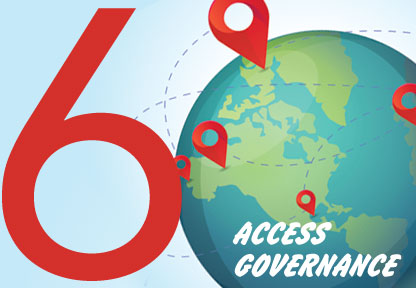Global access governance is no longer optional. Once a problem for large corporations alone, most companies now have operations in multiple countries. This global expansion is valuable; it brings more opportunities for growth, access to new markets, and talent. However, there’s a downside to that expansion. Traditional access governance programs are no longer enough. Fortunately, you’ve come to the right place. We’ll guide you through the process of developing a global access governance program in six steps.
Your Road to Global Access Governance Starts Here
Organizing a global access governance program is a significant undertaking. There are many stakeholders to consider, such as local compliance officers. These six steps will help to get you started. Before we do anything else, it’s critical to ground your project planning in the facts.
1. Evaluate Your Current State of Access Governance
You want to bring global access governance to your organization. That’s fantastic! Will that be an easy task or a daunting task? Without evaluating your current state of access, there’s no way to answer that question. In this step, you want to identify the organization’s overall access governance maturity to determine where to focus your efforts.
Answer these self-assessment questions to get started:
- Access governance policy and procedures: Does the organization have these documents in place? Note that they may be embedded into other documents, such as an IT security policy. If these elements aren’t in place, you’ll be more likely to encounter inconsistent practices.
- Access governance training: How do you provide access governance training to employees? Do staff members know when and how to use multi-factor authentication? Ideally, we recommend providing an annual IT security training program to all employees with coverage of access best practices.
- Access governance monitoring: What data do you have about your program’s effectiveness? Unless this reporting is in place, you can’t assess your program.
- Access governance international support: Evaluate how well your access governance program adopts to meet local needs, including supporting different languages.
Now that you’re equipped with an understanding of your current situation, you can move on to the next step.
2. Review Your Global Goals and Resources for IT Security
Your access governance program is ultimately a contributing factor to the organization’s overall IT security strategy. To persuade executives to provide support for global access governance, you need to make a clear connection to your goals. For example, let’s say your company recently expanded into France and Germany from the United States. For those new offices to succeed, you’ll need to respect local regulations such as GDPR (General Data Protection Regulation), which expects high levels of data security. Therefore, you can make the case that global access governance contributes to your company’s goal of meeting IT security requirements for every country you operate in.
Tip: What if you don’t see an organization goal that can be linked to access governance? In that case, ask around about recent IT audits and security failures. You may find that there’s a project underway to improve security in response. In that situation, you may be able to enhance those efforts by strengthening access governance.
3. Evaluate Your Program’s Scalability
Expanding your access governance program from one country to multiple countries is easy if you have a scalable program. In our experience, one factor shapes whether you have a scalable program: automation. When your access governance program relies upon manual actions to approve, change, or remove access, expanding it further is difficult.
To bring automation to your access program, you need a software solution in place.
4. Implement Access Governance Software
Installing an access governance software solution is a project in itself. In working through these steps, you may want to limit yourself to creating a shortlist of solutions. Naturally, we recommend taking a close look at Compliance Auditor. It automatically logs all access governance activities and comments in one place. Thus, your next IT audit will be a breeze.
5. Find Local Allies
In building your access governance across the world, you can’t be everywhere. The solution is simple: recruit local allies who can support the project. In most cases, it makes sense to start by looking at the local IT manager or executive to sponsor this project. Involve these allies in designing the project so that their needs are covered fully. This local engagement will also help you with support and training because your local partners can support your efforts.
6. Start with One Region at a Time
In this step, you’ll need to make an important decision: choose one country or location to focus on first. If you have operations in multiple countries, making the choice may feel challenging. We recommend looking for an easy win in access governance. Based on discussions with your local allies, who’s the most engaged and capable to roll out access governance? By focusing on the most enthusiastic jurisdiction first, your global access governance rollout will start on a successful note.
How Do You Know if Your Global Access Governance Program Is Working?
No IT security program can ever be declared 100% effective. New threats are developing every day, and researchers are discovering new vulnerabilities all the time. You can measure whether your program is working well in a few ways. Start by examining your IT security metrics, such as access management KPIs. Next, reach out to your auditors and ask them if they’ve evaluated identity and access management in their audits. Finally, you can contact a cybersecurity consultant and invite him or her to assess your program. Taken together, these techniques will help you keep your access governance program up to date.




